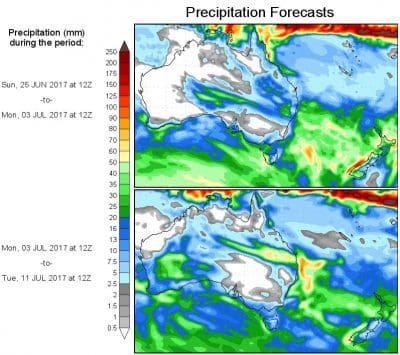WITH winter crop sowing in its final stages across Australia, Grain Central this week takes a state-by-state look at what sort of planting season it has been. Today the focus is on Queensland.
………………………………………
TIME is running out for winter crop plantings on Queensland’s Darling Downs where dry conditions have seen a shortfall in anticipated plantings and growers resorting to deep sowing, moisture seeking techniques to establish chickpeas.
There is the chance of a rain event at the turn of the week that is giving growers some hope they might receive enough to round off winter sowing programs, but that hope is tempered by forecasts of rain earlier in the season that failed to materialise.
Dalby Rural Supplies head agronomist, Andrew Johnston, said there had been no substantial rain on the Darling Downs since spinoff falls from Cyclone Debbie in late March/early April, and balmy conditions prevailed again this week.
“It has been beautiful weather if you live on the coast and want to take in the sunshine, but there has been no rain here since Cyclone Debbie,” he said.
“It is surprising how much crop has gone in considering how dry it has been.”
Mr Johnston estimated 70 per cent of the planned chickpea crop had now been sown on the Darling Downs but less than 10pc of the cereals had been planted to date.
He said the focus for many growers had been on planting chickpeas which were attractively priced and could be sown at depth to reach moisture.
“There are still growers deep-planting chickpeas down to seven or eight inches (18-20cm) which is not ideal. They will take a month to come out of the ground,” he said.
“If chickpeas were worth $400/tonne you wouldn’t even consider it, but when they are worth in excess of $800/t growers are prepared to take a punt on it.
“You just have to be very careful. It is a costly exercise and you have to make sure you have your residual herbicides worked out. You don’t want to go and put a residual herbicide in that is going to lock you out of putting summer crop in if we don’t get any more rain.”
Mr Johnston said while there was some chance of rain at the end of this week, the Downs would need at least 30 millimetres to really get sowing rolling.
“If we get rain, there will be plenty of guys who will plant. It is mainly off the back of high prices. Even with wheat and barley, plenty of guys will put it in because the price is reasonable at the moment. It is just a waiting game.”
He said some growers would still plant through to mid-July, but that would put a lot of pressure on having a cool spring for chickpeas which were temperature-driven and needed a cool September/October to get late-flowering crops through.
“We got away with it last season when we had a cool spring through September/October/early November and the late chickpeas performed very well,” he said.
“We have had a mild winter so far but we will need a cool spring for late chickpeas. But that comes with a risk for early, spring-plant sorghum and cotton. Last spring created issues with spring plantings because it was cool, but the trade-off was it was very good for the late chickpeas.”
AgForce grains president, Wayne Newton, said it had been “a tough story” on the Darling Downs where growers had been hoping for follow up rains after the spinoff falls from Cyclone Debbie, but they never came.
Mr Newton said if it did rain in the next week or so there would still be a significant number of growers who would “have a crack” at sowing, particularly on the eastern Downs where there was a more opportune planting time frame.
While the focus would be on chickpeas, growers might revisit wheat and barley plantings based on a slight improvement in prices.
“Cereal prices have rallied a bit in the last week with production difficulties in parts of the United States and the Western Australian crop has largely not been sown. All the factors combined have seen a gradual rally in the world price, so that may tempt some growers back into wheat or barley,” he said.
It is a much brighter picture in Central Queensland (CQ) where the planting program has been completed and crops are generally looking in good shape.
Mr Newton said there had been a substantial winter crop planting post-Cyclone Debbie across CQ but a lot of areas were now looking for a top-up shower of rain.
“There has been follow up rain in the north-east areas of CQ but as you head back to the south-west it gets somewhat drier and there wasn’t as much rain from Debbie either,” he said.
In south-west Queensland, Mr Newton said sowings had been patchy as the area didn’t receive much of the spinoff rain from Cyclone Debbie, but a large acreage of winter crop had gone in.
“There has been a significant amount of chickpeas planted on chickpeas which is causing agronomists and plant pathologists some heartburn,” he said.
Grain Central: Get our free daily cropping news straight to your inbox – Click here



HAVE YOUR SAY